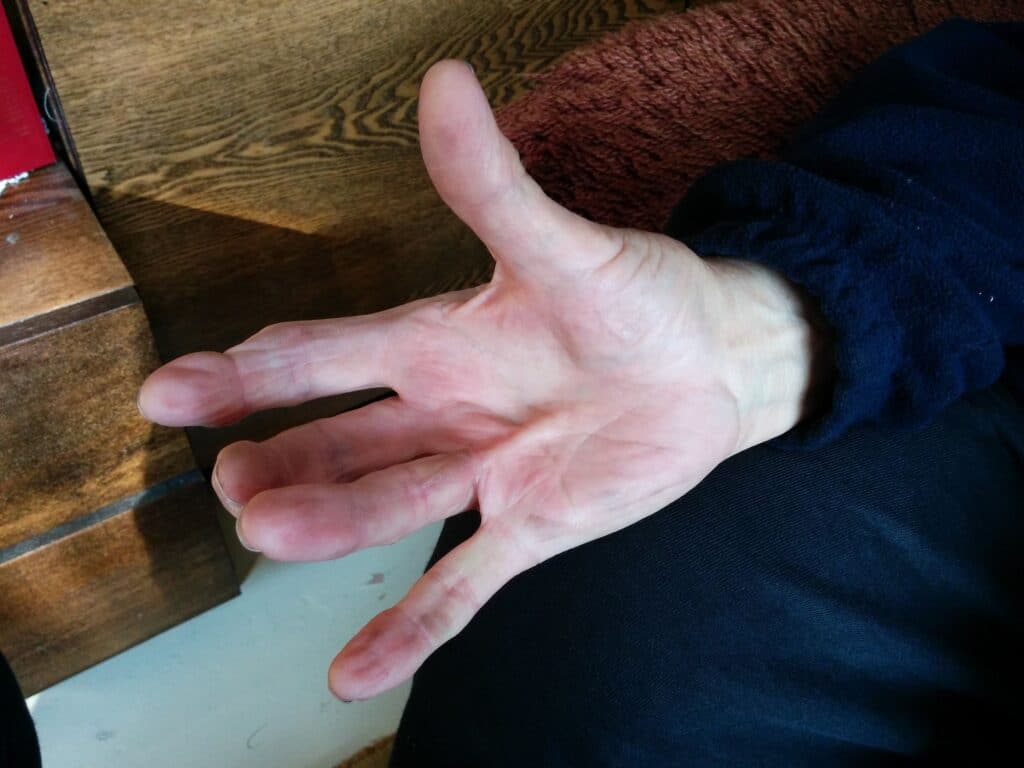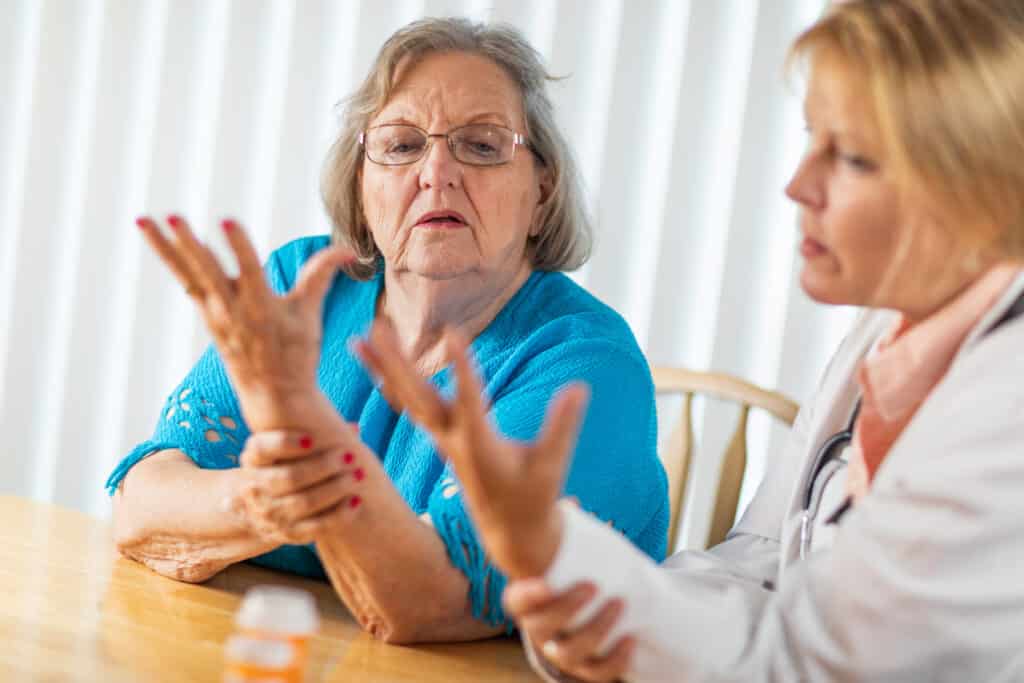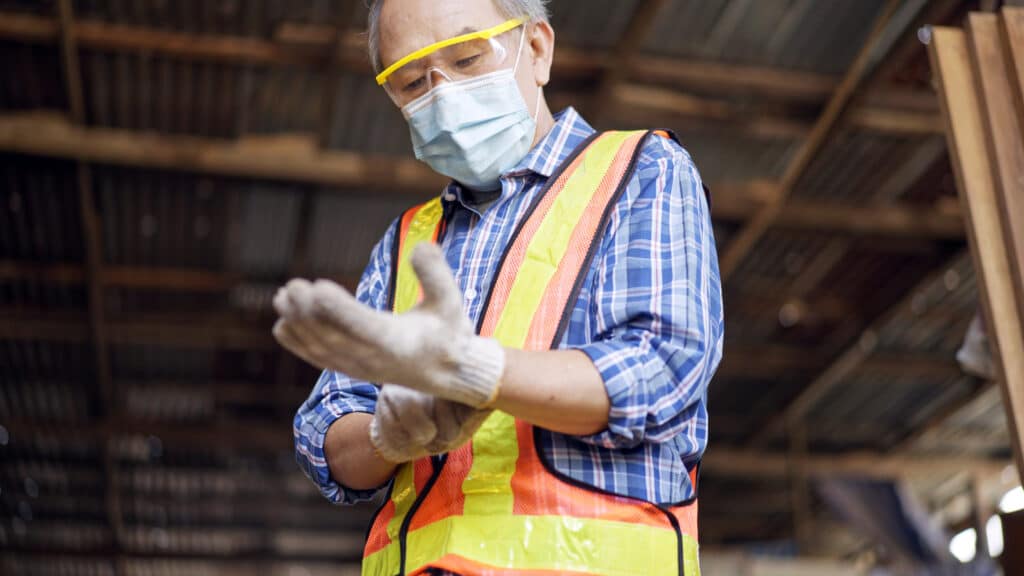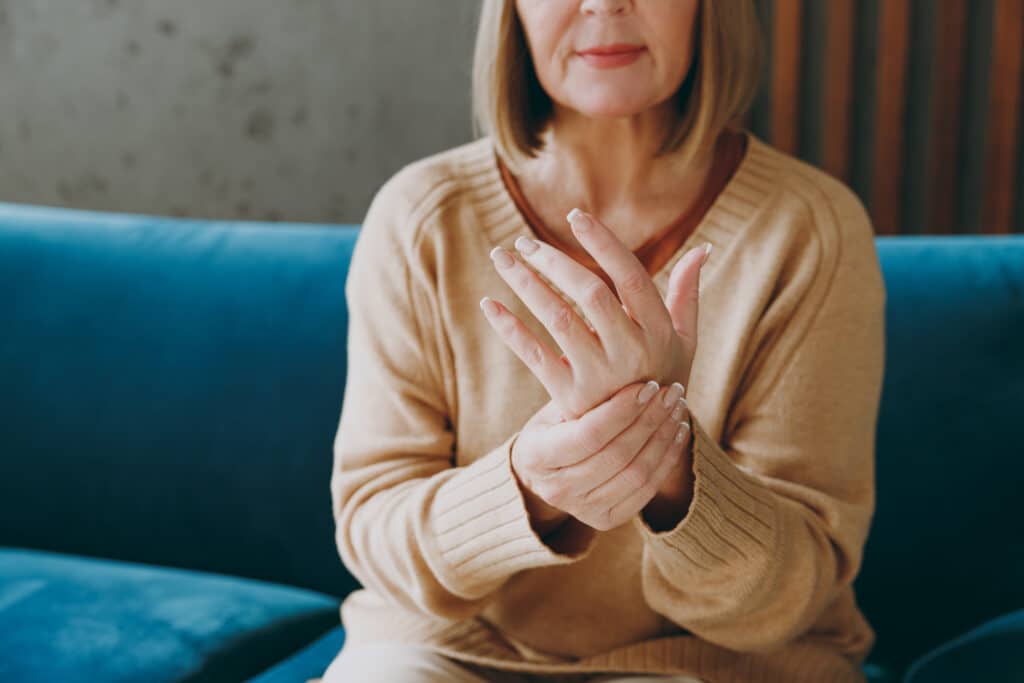Dupuytren’s contracture might sound like a mouthful, but it’s a common hand condition many seniors encounter with age. Starting subtly with a small nodule in the palm, this condition can eventually cause our fingers — typically the ring and pinky — to bend inwards. In this article, I’ll delve deep into its nuances, exploring its symptoms, causes, treatments, and ways to manage it effectively.
What is Dupuytren’s Contracture?
Dupuytren’s contracture is a condition that affects the fascia, a layer of tissue beneath the skin in your palm. Fascia acts as a layer of connective tissue to hold muscles, nerve fibers, tendons and ligaments in place.
Gradually, this fascia can thicken and tighten, leading to one or more fingers bending inward towards the palm. This often occurs primarily in the ring finger and pinky finger. While this condition is not dangerous, it can still cause discomfort and lead to challenges with everyday activities.

Symptoms of Dupuytren’s Contracture:
Spotting Dupuytren’s contracture in its early stages is vital for successfully managing the condition. Symptoms typically develop slowly and may start with a small lump or nodule in the palm.
Here are the key symptoms (and the order in which they tend to occur) that may become more noticeable as the condition progresses:
A Firm Lump or Nodule
The early sign of Dupuytren’s contracture is a small, firm lump or nodule that forms under the skin of the palm. This lump may be painless and is often mistaken for a harmless growth.
Thickened Cords in the Palm
Over time, the lump may develop into thickened tissue cords extending from the palm to one or more fingers. These cords can feel like ropey bands under the skin.
Finger Contracture
As the cords tighten, affected fingers may gradually bend inward towards the palm. This bending or contracture can lead to the finger being unable to straighten fully, possibly becoming permanently curled.
Limited Finger Movement
Due to contracture, individuals with Dupuytren’s contracture may experience limited finger movement, making it challenging to perform everyday tasks that require fully gripping or extending the fingers. Tasks affected might include putting on gloves, holding objects, and shaking hands.
Hand Deformity
In severe cases, the condition can cause significant hand deformity, with multiple fingers affected and the hand assuming a claw-like appearance.
It’s important to note that Dupuytren’s contracture progresses at a variable rate for different people. While the condition is not typically painful in its early stages, the contracture and loss of hand function can cause discomfort and impact daily activities as it progresses.
If you notice any of these symptoms or have concerns about your hand function, it’s essential to seek evaluation and advice from a healthcare professional to determine the appropriate course of action. Early detection and treatment can help manage the condition effectively and improve hand mobility and function.
Causes and Risk Factors of Dupuytren’s Contracture:

The exact cause of Dupuytren’s contracture remains unclear, but researchers believe that genetic and environmental factors play a role in its development. The condition is more prevalent in certain populations, such as those of Northern European descent, and tends to run in families, suggesting a genetic component.
Additionally, several risk factors have been identified that may increase the likelihood of developing Dupuytren’s contracture:
- Genetics: Family history is one of the most significant risk factors for Dupuytren’s contracture. If you have a close relative, such as a parent or sibling, who has the condition, your risk of developing it increases.
- Age & Gender: Dupuytren’s contracture is more common in older adults, especially men over 50. While women can also develop the condition, it is less frequent.
- Ancestry: The condition is more prevalent in people of Northern European descent, including those with Scandinavian, Irish, or Northern English ancestry.
- Diabetes: Individuals with diabetes risk developing Dupuytren’s contracture more than the general population. The exact relationship between diabetes and the condition is not fully understood.
- Alcohol Consumption: Heavy or prolonged alcohol consumption has been associated with an increased risk of Dupuytren’s contracture. Alcohol may contribute to the development of the condition by affecting the connective tissues in the hand.
- Smoking has been identified as a risk factor for Dupuytren’s contracture. It is believed that smoking may contribute to the development of the condition by reducing blood flow to the hands and affecting collagen production.
- Occupational Factors: Certain occupational activities involving repetitive hand movements or using vibrating tools may increase the risk of developing Dupuytren’s contracture.
Will I Get This Condition?
It’s essential to understand that these are only identified risk factors, and not everyone with them will necessarily develop Dupuytren’s contracture.
Individuals without these risk factors can still be affected by the condition. The interplay of genetic and environmental factors in each individual’s case makes the development of Dupuytren’s contracture complex and multifactorial.
Diagnosis and Treatment of Dupuytren’s Contracture

If these symptoms sound familiar to you, seeking advice from a healthcare professional is essential for an accurate diagnosis. Diagnosis involves a physical examination, where the doctor will look for the characteristic signs of the condition.
Treatment options for Dupuytren’s contracture depend on the severity of the symptoms and their impact on an individual’s quality of life. In mild cases, treatment may not be necessary immediately, but regular monitoring is advised. However, when treatment is needed, options include:
Physical Therapy & Hand Exercises
Hand therapy can be beneficial in improving hand function and reducing discomfort associated with Dupuytren’s contracture. This may include hand exercises, soft tissue mobilization, heat or cold therapy, and splinting.
Hand exercises are a central aspect of physical therapy for Dupuytren’s contracture. These exercises aim to stretch and strengthen the affected hand and fingers. Your physical therapist will guide you through movements to improve finger mobility and flexibility.
Regular practice of these exercises can help slow the progression of contractures and improve hand function.
Other Treatment Option
Certain medications can be injected into the affected area to help soften the thickened tissue and improve finger movement.
Needling is a procedure in which a doctor inserts a needle into the affected area to break the tight bands and improve finger extension.
Surgical intervention may be required for more advanced cases to release the tight bands and improve hand function. Like all surgeries, this should be a last resort if your condition dramatically affects your well-being.
Possible Complications Related to These Treatments
While Dupuytren’s contracture is not life-threatening, it can lead to complications that may impact hand function and daily life. These complications include:
- Infection at the injection or surgical site: For those who undergo injections or surgical interventions to treat Dupuytren’s contracture, there is a potential risk of developing an infection at the procedure site. Infection can cause pain and swelling and may require additional medical treatment.
- Nerve damage: In some cases, the treatment procedures, particularly surgery, may inadvertently damage nerves in the hand. Nerve damage can lead to altered sensation, weakness, or even loss of movement in the affected hand.
- Recurrence of the condition after treatment: After undergoing treatment for Dupuytren’s contracture, the condition may return. The recurrence risk depends on the original contracture’s severity and treatment method.
Prevention Methods for Dupuytren’s Contracture

While there is no definitive way to prevent Dupuytren’s contracture, certain measures may help reduce the risk or slow its progression.
Trying to quit smoking and moderating alcohol intake may help lower the risk by removing preventable risk factors for DC.
Engaging in self-care can be beneficial in minimizing stress and strain on the hands. For example, using gloves while performing activities that involve exposure to chemicals or mechanical stress can help protect the hands and reduce the risk of injury.
If your job requires repetitive use of tools or equipment, padding on the palm can help distribute pressure and reduce the risk of developing hand injuries or exacerbating existing contractures.
Including regular hand stretches in your daily routines can help maintain hand health and flexibility. Stretching exercises can also benefit those with early-stage Dupuytren’s contracture in managing the condition’s progression.
While these preventive measures may not entirely eliminate the risk of Dupuytren’s contracture, adopting a proactive approach to hand health can improve overall hand function and quality of life.
If you have a family history of Dupuytren’s contracture or notice any early symptoms, consulting with a healthcare professional can help in early detection and appropriate management.
Key Takeaways
- Dupuytren’s Contracture causes the hand’s fascia to thicken and fingers, especially the ring and pinky, to bend inwards, starting with a noticeable lump in the palm.
- The condition has a strong genetic link, being especially prevalent among those of Northern European descent, and other risk factors include age (particularly in men over 50), diabetes, heavy alcohol consumption, smoking, and specific occupational activities.
- Diagnosis typically involves a physical examination, with treatment options spanning from hand exercises to invasive surgery.
- Potential complications from treatment can encompass infections, nerve damage, or a recurrence of the condition.
- While there’s no guaranteed prevention method, reducing smoking, moderating alcohol intake, performing regular hand stretches, and early medical consultation can aid in management and risk reduction.
FAQs
Can Dupuytren’s Contracture affect parts of the body other than the hands?
While Dupuytren’s Contracture primarily affects the hands, there are related conditions where similar tissue changes can occur in other parts of the body. For instance, Ledderhose disease (or plantar fibromatosis) affects the feet, causing nodules to form on the arch. However, Dupuytren’s Contracture itself is specific to the hands.
How long does it usually take for Dupuytren’s Contracture to go from a small lump to affecting the fingers?
The progression of Dupuytren’s Contracture can vary widely among individuals. For some, the condition may take years or even decades to progress significantly. For others, the changes can occur more rapidly. Factors such as age, genetics, and other risk factors can influence the speed of progression.
Are there any new non-surgery treatments being studied for Dupuytren’s Contracture?
Researchers have been exploring various non-surgical treatments for Dupuytren’s Contracture. Collagenase injections have been approved for treating the condition by breaking down the thickened collagen in the hand. Additionally, radiation therapy in the early stages of the disease has been studied as a possible preventive measure. Research is ongoing, and newer treatments might emerge in the future.
Do men and women experience Dupuytren’s Contracture differently in terms of severity?
Yes, there are gender differences in the presentation and progression of Dupuytren’s Contracture. Men are more likely to develop the condition and often at a younger age compared to women. Additionally, men might experience more severe contractures. However, the exact reasons for these differences are not fully understood and might be related to genetic, hormonal, and environmental factors.
References
- Mella, J. R., Guo, L., & Hung, V. (2018). Dupuytren’s Contracture: An Evidence Based Review. Annals of plastic surgery, 81(6S Suppl 1), S97–S101. https://doi.org/10.1097/SAP.0000000000001607
- Feldman G, Rozen N, Rubin G. Dupuytren’s Contracture: Current Treatment Methods. Isr Med Assoc J. 2017 Oct;19(10):648-650. PMID: 2910324
- Ball C, Izadi D, Verjee LS, Chan J, Nanchahal J. Systematic review of non-surgical treatments for early dupuytren’s disease. BMC Musculoskelet Disord. 2016 Aug 15;17(1):345. doi: 10.1186/s12891-016-1200-y. PMID: 27526686; PMCID: PMC4986253.7. PMID: 30161050.6.
- Turesson C. The Role of Hand Therapy in Dupuytren Disease. Hand Clin. 2018 Aug;34(3):395-401. doi: 10.1016/j.hcl.2018.03.0
- Huisstede BM, Gladdines S, Randsdorp MS, Koes BW. Effectiveness of Conservative, Surgical, and Postsurgical Interventions for Trigger Finger, Dupuytren Disease, and De Quervain Disease: A Systematic Review. Arch Phys Med Rehabil. 2018 Aug;99(8):1635-1649.e21. doi: 10.1016/j.apmr.2017.07.014. Epub 2017 Aug 30. PMID: 28860097.08. PMID: 30012299.






